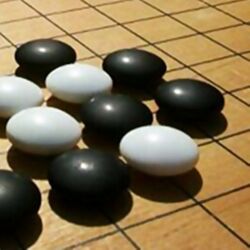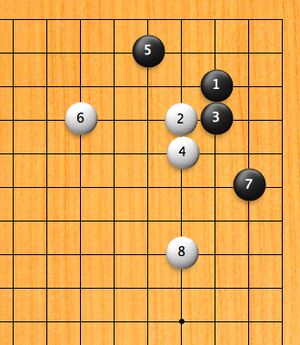Software:Jōseki
| Part of a series on |
| Go |
|---|
 |
| Game specifics |
|
| History and culture |
| Players and organizations |
| Computers and mathematics |
In go and shōgi, a jōseki or jouseki (kanji characters 定石 for go, 定跡 for shōgi) is the studied sequences of moves for which the result is considered balanced for both black and white sides.
Go jōsekis
In go, because games typically start with plays in the corners, go jōsekis are usually about corner play as the players try to gain local advantages there in order to obtain a better overall position. Though less common, there are also jōsekis for the middle game. In Japanese, jō (定) means "fixed" or "set" and seki (石) means stones, giving the literal meaning "set stones", as in "set pattern". In Chinese, the term for joseki is dìngshì (定式).
The concept of "balance", here, often refers to an equitable trade-off between securing territory in the corner versus making good thickness toward the sides and the center. In application, these concepts are very dynamic, and, often, deviations from a jōseki depend upon the needs of the situation and the available opportunities. While learning jōseki is a tool to defend against a local loss, players always seek to take advantage of weaknesses in the opponent's shapes, often deviating from the jōseki.
Using jōseki
Jōsekis are not fixed but comprise patterns that have gained acceptance in professional games; they constitute a consensus that may change with certain caveats. Hence, the basic definition may be misleading for new players in that a jōseki can be misconstrued as foolproof and unalterable and as optimal for all situations. Many jōsekis are in fact useful only for study within an artificially confined corner,[1] and in real play are only considered good form when used in proper combination with other plays on the board (i.e. other jōseki and fuseki moves).
Knowing a particular jōseki simply means that one knows a sequence of moves, resulting in a balance or fair trade-off between black and white positions. This is in practice much easier than appraising how jōsekis relate to the rest of the board – hence, knowledge of jōseki is regarded as shallow, when compared with the ability to integrate a strategy into a complex game landscape.
One go proverb states that "learning jōsekis loses two stones in strength," which means that the rote learning of sequences is not advantageous; rather, learning from a jōseki should be a player's goal. Hence, the study of jōsekis is regarded as a double-edged sword and useful only if learned by understanding the principles behind each move, instead of by rote. Every jōseki should be used as a specific tool that leaves the board in a particular shape.
Just as using an improper tool in machinery can be devastating, choosing the wrong jōseki can easily be worse than improvising one's own moves. In his book A Way of Play for the 21st Century, Go Seigen compared choosing the proper jōseki to choosing the proper medicine: "Pick the right one, and you feel better. Pick the wrong one, and you die." [par.] Rui Naiwei similarly remarked that "playing josekis is easy [but] choosing the right one [in a game] is hard." [par.]
A jōseki may fall out of use for various reasons, some of which may often seem minor to the amateur player; professionals may consider one variation suboptimal for a very specific reason – one which strong amateurs are not likely to exploit. There is no definitive guide to what is a jōseki; the situation with jōseki dictionaries is similar to that of natural language dictionaries: some entries are obsolete, and the list is likely to be incomplete.
Basic jōseki
Corner jōsekis conventionally start with one player occupying a corner point, in an empty 19×19 area of the board, and the other player replying with an approach move (Japanese: kakari). The initial play in the corner is almost always on a 3-3, 3-4, 3-5, 4-4 or 4-5 point. Other plays that have been experimented with include 5-5, 6-3 and 6-4, all of which sacrifice territory for influence.
Of those plays, the classical 3-4 point (komoku) and more contemporary 4-4 point (hoshi) are the most used. The standard approaches are at 5-3 or 5-4 to the 3-4 point, and at 3-6/6-3 to the 4-4 point. The number of subsequent variations is then quite large (of the order of ten reasonable plays for the next one).
|
| |||||||||||||||||||||||||||||||||||||||||||||||||||||||||||||||||||||||||||||||||||||||||||||||||||||||||||||||||||||||||||||||||||||||||||||||||||||||||||||||||||||||||||||||||||||||||||||||||||||||||||||||||||||||||||||||||||||||||||||||||||||||||||||||||||||||||||||||||||||||||||||||||||||||||||||||||||||||||||||||||||||||||||||||||||||||||||||||||||||||||
| A Go game opening with two common jōsekis in the upper-right and lower-left. |
Also useful is the tenuki concept of breaking away from a sequence, to play elsewhere, before the 'official' endpoint of the jōseki. After a jōseki sequence has ended, a play returning to the same area may be termed a follow-up play. There is no formal theory for these, though numerous set sequences can be seen in professional play.
It is imperative that players should not play a jōseki merely from rote memorization but adapt according to the overall board situation. It is important to keep in mind that go is a game involving marginal analysis and jōsekis are merely heuristics of sound play. Playing jōsekis blindly will not improve one's game.[citation needed]
See also
- Go opening theory
- Fuseki
- Avalanche joseki
- Taisha joseki
- Shogi opening
References
External links


